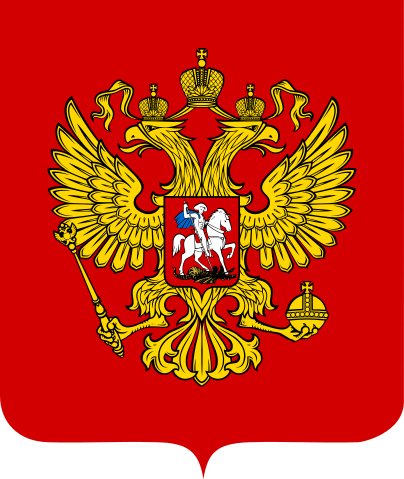 |
This is a file from the Wikimedia Commons. Information from its description page there is shown below.
Commons is a freely licensed media file repository. You can help.
|
| Description |
Coat of Arms of the Russian Federation.svg
English: The Coat of Arms of Russian Federation.
Esperanto: Blazono de Rusia Federacio.
Français : Armoiries de la Fédération de Russie.
Italiano: Stemma della Federazione Russa.
Русский: Герб Российской Федерации. Многоцветный вариант на геральдическом щите.
Українська: Герб Російської Федерації.
|
| Date |
2000 |
| Source |
The official source of the image is http://document.kremlin.ru/doc.asp?ID=5171&PSC=1&PT=3&Page=8. The big image of coat of arms: . |
| Author |
Федеральный конституционный закон «О Государственном гербе Российской Федерации» |
Both variants were drawn in SVG by User:Zscout370.
- Fisrt was initially loaded to En-Wiki on 22 November 2006 (description was here).
- Second was loaded by author to Commons.
Licensing
 |
This image shows a flag, a coat of arms, a seal or some other official insignia. The use of such symbols is restricted in many countries. These restrictions are independent of the copyright status.
|
For the Russian Federation
Esperanto: En Rusia Federacio
| Public domainPublic domainfalsefalse |
 |
This work is not an object of copyright according to Part IV of Civil Code No. 230-FZ of the Russian Federation of December 18, 2006. Article 1259. Objects of Copyright
Paragraph 5
- Copyright shall not apply to ideas, concepts, principles, methods, processes, systems, means, solutions of technical, organizational and other problems, discoveries, facts, programming languages.
Paragraph 6
- Shall not be objects of copyright:
- official documents of state government agencies and local government agencies of municipal formations, including laws, other legal texts, judicial decisions, other materials of legislative, administrative and judicial character, official documents of international organizations, as well as their official translations;
- state symbols and signs (flags, emblems, orders, banknotes, and the like), as well as symbols and signs of municipal formations;
- works of folk art (folklore), which don't have specific authors;
- news reports on events and facts, which have a purely informational character (daily news reports, television programs, transportation schedules, and the like).
Full text of the Code: in Russian in English.
|
|
Comment – According to interstate and international compacts, the Russian Federation is the legal successor of the Russian Soviet Federative Socialist Republic and the Union of Soviet Socialist Republics; therefore, this license tag is also applicable to official symbols and formal documents of the Russian SFSR and the USSR (union level).
Warning – This license tag cannot be applied to proposed official symbols and drafts of formal documents, which can be copyrighted.
- ↑ The union level means that use of official symbols and the formal documents of 14 other Soviet Republics is the subject of law of their legal successor. See respective license tags.
|
Elsewhere
Esperanto: En ceteraj landoj
derivative works
Esperanto: Derivaĵoj
Derivative works of this file:
File usage
The following pages on Schools Wikipedia link to this image (list may be incomplete):
This file contains additional information, probably added from the digital camera or scanner used to create or digitize it. If the file has been modified from its original state, some details may not fully reflect the modified file.
Through Schools Wikipedia, SOS Children's Villages has brought learning to children around the world. By supporting vulnerable children right through to adulthood, SOS Children makes a lasting difference to the lives of thousands of people. Education is a key part of our work, and our schools provide high-quality teaching to the children in our care. There are many ways to help with SOS Children.





